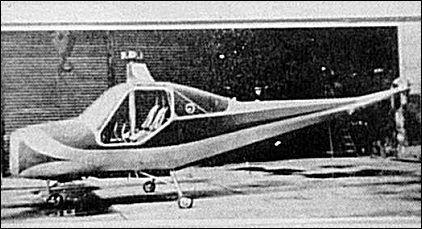|
The Beija-Flor is a small two-seat helicopter which was designed and built by the Department to the initial design of Professor Heinrich Focke, who holds a number of patents concerning some of the original features of the helicopter.
The Beija-Flor is the first helicopter to be designed, built and flown in Brazil and was first flown early in 1959 by Colonel Aldo Vieira da Rosa, a Brazilian Air Force officer and present director of the Instituto de Pesquisas e Desenvolvimento da Aeronautica.
The forward-located 225hp Continental E225 engine drives the main and tail rotors through a centrifugal clutch and a David Brown lorry worm and wheel. The main rotor incorporates a mechanical-hydraulic automatic stabilising mechanism which reduces flapping to zero in the pitch direction.
Roll control is provided by normal "swash-plate" movement. Pitch and yaw control is provided by the unique V-type intermeshing twin tail rotor which also serves to incline the main rotor plane for forward flight.
For economic reasons the material used in the construction of the helicopter is almost entirely of national origin and due to the relatively undeveloped state of the aircraft and accessory industry in Brazil this has unavoidably led to an excessive weight. This situation will however be improved with subsequent prototypes now being planned.
The first flights have concentrated on a preliminary assessment of control and stability and have been remarkably fie-of prototype ""snags". The results so far have been extremely satisfactory. Jane's All the World's Aircraft, 1959-60
The BF-1 Beija Flor was designed in 1956 by Professor Focke at the Centre Tecnico de Aeronautica at the military research and overhaul centre at Sao Jose dos Campos. A two-seater, the Beija Flor had its 225hp Continental E225 engine fitted in the nose, with a short coupling to the rotor pylon which was mounted centrally in front of the crew. An open structure tubular steel tail boom carried a pair of tail surfaces and a small tail rotor. The prototype flew on 1 January 1959, and went through extended flight testing until it was damaged in an accident. It is thought that further work on the Beija Flor was then abandoned. R.Simpson "Airlife's Helicopter and Rotorcraft", 1998
| Technical data for Beija-Flor BF-1
Main rotor diameter: 9.0m,
overall length: 8.43m,
height over rotor hub: 3.15m,
weight loaded: 950kg,
max speed at sea level: 150km/h,
cruise speed for max range: 130km/h,
cruise speed (75% power): 140km/h,
max rate of climb: 370m/min,
service ceiling: 3500m,
max ceiling: 3750m,
hover ceiling with ground effect: 2700m,
hover ceiling without ground effect: 1400m,
range at best cruise speed: 270km,
max endurance: 3h
|
Warning: mysqli_connect(): php_network_getaddresses: getaddrinfo for mysql5.zone.ee failed: Name or service not known in /data03/virt15346/domeenid/www.aviastar.org/htdocs/helicopters_eng/beija-flor_bf-1.php on line 103
Fatal error: Uncaught mysqli_sql_exception: php_network_getaddresses: getaddrinfo for mysql5.zone.ee failed: Name or service not known in /data03/virt15346/domeenid/www.aviastar.org/htdocs/helicopters_eng/beija-flor_bf-1.php:103
Stack trace:
#0 /data03/virt15346/domeenid/www.aviastar.org/htdocs/helicopters_eng/beija-flor_bf-1.php(103): mysqli_connect('mysql5.zone.ee', 'd14657sa18989', Object(SensitiveParameterValue))
#1 {main}
thrown in /data03/virt15346/domeenid/www.aviastar.org/htdocs/helicopters_eng/beija-flor_bf-1.php on line 103
| 




